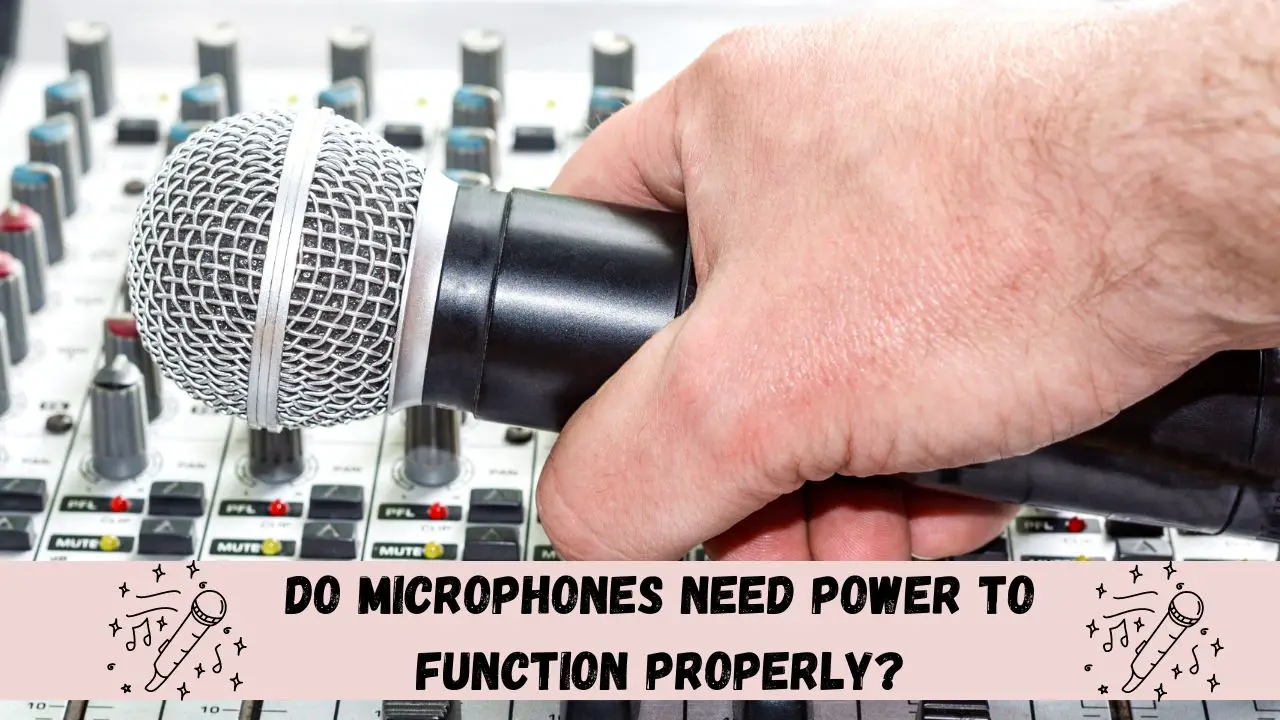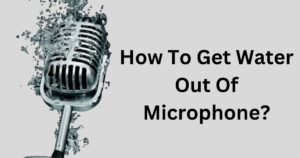In today’s dynamic world, the life of people changes within a second. Following current trends of dynamics, people are adopting advancement in technology that helps to change their life.
Nowadays, microphones are used in different applications like telephone, public address systems, hearing aids, and many more. Thus, the use of microphones is quite widespread nowadays.
But do you have enough knowledge about this amazing tool? Do you know the need for electricity to manage this device? The need for power may vary from one device to another.
Do your microphones need the power to function properly?
Well, if you are curious about knowing microphones in detail, these questions are very natural to pop up. In this article, we will discuss all you need to know about microphones and their need for power. So, stay tight and read the article till the end.
Different types of microphones
Microphone is an interesting device that can capture different sound waves and helps to turn them into electric signals.
After that, signals can be possessed by computers or other types of audio devices.
In case of understanding the need for power in a microphone, you need to first understand that there are some distinct categories of microphones. The types depend on their functional capability.

Dynamic microphone.
The dynamic microphone is one of the common microphones that adopt very simple attributes. It consists mainly of a magnet and a metal coil. The intern structure is also very simple, where a diaphragm is placed on the end of the magnet. The magnet is used to transmit the sent vibrations mainly from the sound wave to the coil.
Condenser microphone.
Of late, it is one of the most widely used recording devices. It mainly records the voice of people. Are you really wondering, “what are the wide applications of this microphone?”.
Microphones are used in many different applications like telephone, mobile phones, hearing aid systems, and many more. It is widely used in audio- recording systems that created a revolution in the audio industry.
Ribbon microphone.
The name “ribbon” sounds a little quirky. Isn’t it? It ramifies with a magnetic field and one thin ribbon that is made up of aluminum, nanofilm, and duralumin. These mics use the most powerful magnets. In today’s world, people like to prefer these mics instead of condensers because of their natural sound capturing ability.
Types of microphones that need phantom power
There are some mics that utilize power to maintain their function, but others do not require it. Now the question that you might want to ask is – what types of mics really need the power to improve their function? Well! You already know about the types of mics that we use nowadays. All mics do not require power to improve their function. For instance, the dynamic mics are quite simple and do not require any kind of electricity to last long.
Do condenser mics need phantom power?
The answer is ‘yes’. Condenser mics need electric power sources, which come from the external source of 48 volts of phantom power.
Besides, the ribbon mics also require phantom power. In this case, you should remember that you must use ribbons with the presence of phantom power as it may hinder the utility of ribbons.
Now you can ask, do wireless microphones need phantom power, or do dynamic mics need phantom power?
In answer, the wireless phones actually do not need phantom power as it mainly depends on the battery power. The battery power helps to take overload that helps to manage the work of mics.
Only wired mics like condensers require phantom power to work. In that case, you can say that the mics that utilize power are mainly known as active mics.
Other mics which do not use any power, are known as passive mics. Therefore, condensers and ribbons are the perfect examples of active mics. On the other hand, dynamic mics are considered passive mics.
Do USB microphones require phantom power?

Well! In the past decades, USB microphone has flooded the market, and there were many audio users utilizing USB microphone. Using a USB microphone makes audio listening easy on your computer device. In that case, the USB and the computer can easily connect with each other to maintain an automatic communication system.
A computer can easily choose a USB as its input device. It mainly works as a driver of devices on your computer.
But if you want to gather knowledge about the USB microphone power, then you must know that USB microphones can carry only 5 volts.
The use of 5 volts is helpful to make the connection successful. However, you can not send 48 volts at a time through a USB cable.
The amazing utility features of USBs help to record the overall communications within the computer. Now the question is, do USB microphones really need phantom power to charge themselves?
The answer is no. A USB gets power already from the computer, and this is the reason that the USB does not require phantom power. A USB has enough capability to receive the audio, then transforms that audio internally, and finally send it back to the computer using the cable.
Does Shure SM57 requires phantom power?

Now, you might wonder what Shure SM57 is and what type of specialty you can find with this microphone? The Shure SM57 is a dynamic microphone that consists of some luring features. The luring features of this microphone make it unique. Of late, it’s quite famous in the musical industry, and musicians have used this microphone in a wide range. They are using musical instruments that they pick up for the vocals. It is quite bright and helps to deliver a clean sound to the people. The SM57 is ideal for improving sound reinforcement and making a better recording system.
Generally, the one question that can easily increase your curiosity is – does Shure SM57 require phantom power? Shure SM57 is a dynamic microphone that can avoid the use of phantom power. It is quite a professional and well-balanced dynamic microphone that does not require any kind of phantom power. Isn’t it interesting?
What is phantom power?
The continued use of words like “phantom power” might make you take more interest in knowing this concept. You may explore more to clear this concept. Phantom power is mainly a piece of professional audio equipment where DC electric power can transmit the microphone cables to the operating microphones.
The phantom power is mainly designated as +48V or P48. Mainly the condenser microphones use phantom power to avoid bulky external suppliers. The phantom power is useful for using the current DC which is sent through the XLR cable.
Additionally, the required voltage plays a major role in increasing the power of the microphone. The true condenser microphones require a voltage, and phantom power helps to serve the voltage for enhancing their purposes.
Then you may want to know,
how do you check phantom power?
Phantom power is required for improving microphone functions. You can say that phantom power is a powerful method that helps to provide active elements to the active microphones.
The +48 voltage is the standard voltage of phantom power, and other common voltages include +12 vol, +15 vol, +18 vol, +24 vol, and +48 vol.
How does phantom power work?

Phantom power produces mainly electricity, but the phantom power sources may include standalone phantom power, microphone preamplifiers, audio interfaces, audio mixing consoles, and many more. Basically, phantom power is provided through balanced cables, which mainly do not create a negative impact on sounds.
The sources of phantom power are effective in converting the main power to battery power. It is one of the typical uses for delivering +48volts to the direct current or DC.
What is DC bias voltage?
A bias voltage is mainly a low DC voltage, and the range of DC lies between 1.5 voltage to 9.5 voltage DC. It is mainly used for powering electric circuitry that is located within a condenser mic. Phantom power is considered under DC voltage that is sent to the microphone cable to the condenser mic-capsule.
In addition to that, Phantom power is mainly designed for balancing the audio cables to the audio lines. Besides, the typical XLR cable is used to deliver phantom power. Hence, the +48 volts within the pins can be delivered within 2 and 3, which means it helps to deliver the positive and negative audio.
The phantom power works with an effective connection with the balanced audio cable.
The three pins audio cable requires specific wires that include mainly three pins. Pin 1 is the ground or shield wire, Pin 2 is the positive audio signal sire, and Pin 3 requires a negative audio signal wire. Thus, the phantom power mainly works with these three pins, which helps maintain the sound balance.
What is an external microphone power supply?
As you know, phantom power provides power to microphones, and the phantom power is supplied with the help of DC. For instance, the condenser mics have different active electronics, and it needs an external microphone power supply. Hence, the external microphone requires power to maintain its function properly.
Types of microphones that do not use phantom power
There are different microphones that do not use any phantom power. Check the below list to know more about these microphones.
Moving coil microphone :

This dynamic microphone is based on the principle of electromagnetic induction. Electronic induction is considered a passive electrical process. The term ” moving coil” indicates the dynamic approach of coils. Now-a-days, this dynamic microphone is quite more popular than the ribbon microphones. This mic also comes in every shape.
Passive ribbon dynamic microphones:

The passive ribbon microphone also follows the basic principle of electromagnetic induction. The ribbon mic does not have any active components to use. The internal structure of this mic proves the term ” ribbon” is quite perfect; it mainly gets the name for gaining a ribbon-like structure of the diaphragm. It mainly uses the AC voltage to function. Therefore, it does not need any phantom power.
DC biased electret miniature microphones:

DC biased electret miniature microphones work on the DC bias voltage, and it generally uses unbalanced mic cables. It is powered with DC biasing voltage. An electric microphone mainly discards the polarizing power of supply that helps to enhance the perfect Vance of power. In today’s world, it is widely used in recording devices that include telephones, desktops, computers, recording systems, hearing aid, and many more.
Tube microphones:

A tube microphone is an active microphone that uses a vacuum tube. It passes the capsule signals within a tube. The tube microphone is focused on developing capsule signals that are sent through the tube. It is now used for recording the voice and using instruments that are used in the studio. Tube mics are more complex than microphones.
For this reason, it is quite expensive, but now the affordability has increased. A tube microphone is more sensitive, and it also outputs strong audio signals. However, it has acquired a separate power supply that helps to make use of the tube effectively.
The power supply is designed to maintain active components. Therefore, it generally does not require phantom power.
Conclusion
In conclusion, microphones have a huge application and are actively used in the audio and video sectors. The article helps to give us enough knowledge about different types of microphones. It helps to gain knowledge about phantom power. Phantom power has a versatile usage in microphones, and it is used in different microphones. However, phantom power is not used in passive microphones.
This article provides a detailed discussion about which types of mics need the power to function and which work without power. Hopefully, this article helps you to acquire knowledge about using phantom power in different microphones.




